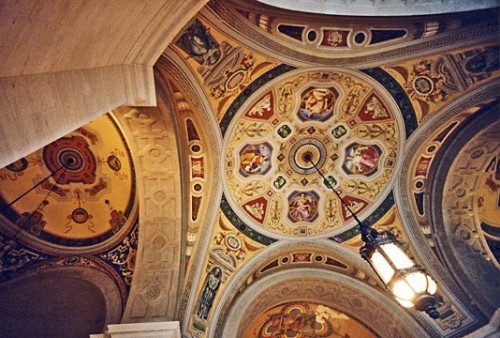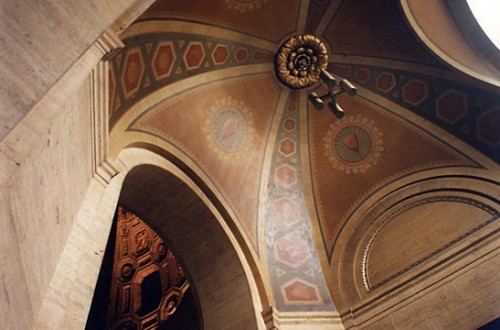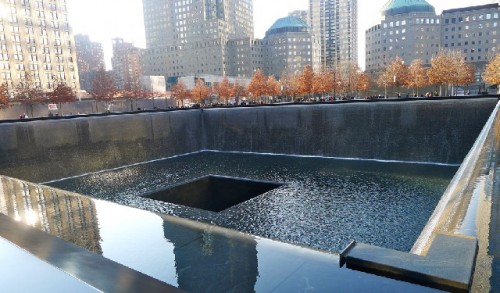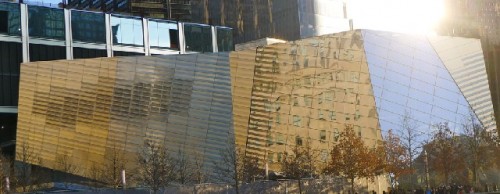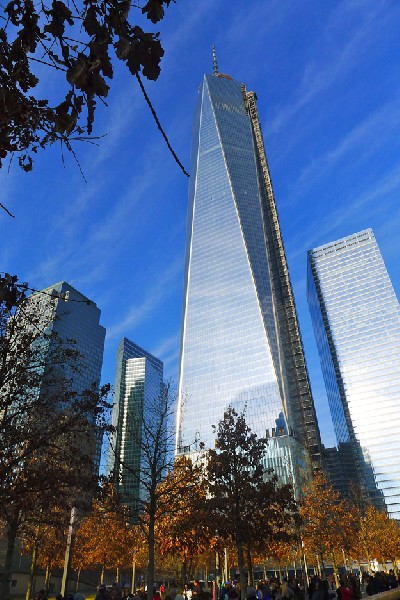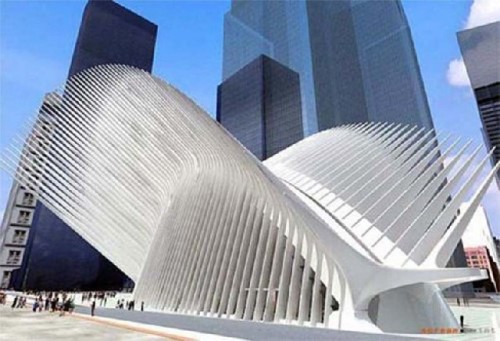New York Sojourn
Trip to NYC Yields Architecture, Art and Theatrical Joy
By: Mark Favermann - Jan 31, 2014
Starting out on a bright , sunny Friday morning from Framingham in my car, almost immediately Lisa and I saw a low flying Bald Eagle fly overhead. Yes, a Bald Eagle! We both saw this as a very good omen for our trip. This turned out to be quite true.
Surprisingly, there was not much traffic the whole way, and we arrived in Manhattan in 3 hours and 1 minute. We had even made a 15 minute rest stop. However, it took about 40 minutes more to get to our hotel.
After depositing the car, checking in and freshening up, we took a cab to 25 Broadway, way, way Downtown. We were suppose to be there by 1 for a quick lunch and then tour. The taxi took seemingly forever. There was congestion and construction all along the way in lower Manhattan. Our Bengladeshi driver was a student engineer. We had a long time to speak to him since the ride took so long.
Finally, we arrived at our destination: the architectural offices of the Norwegian-American firm Snohetta. Interestingly, it was located in the old Cunard Shipping Line Building (1917-21).
When entering the Cunard Building at 25 Broadway, there are many marine themes including starfish, seahorses, shells, sirens, an albatross, and sailing vessels. All are visually celebrated by paintings, murals, motifs and medallions.
It was the headquarters of he Cunard Line and opened in 1919. The Renaissance-inspired limestone exterior leads to a lavish vestibule and great hall where transatlantic voyages were booked. Legendary sea creatures still frolic and dive while Cunard's steamship routes chart the walls.
Due to the increasing popularity of air travel, Cunard was forced to downsize and abandoned 25 Broadway over three decades ago. In 1976, the United States Post Office leased the ornate first floor. This less than elegant use was fitted out in an unsympathetic manner. But this has resulted in retaining the magnificent decorations of the ticketing hall undamaged.
The grand interior of the Great Hall physically illustrates how the then popular Beaux Art style was adapted to a functional use. Set within a huge vaulted space that recalls European cathedrals, Benjamin Wistar Morris, the architect, collaborated with then popular muralist Ezra Winter to produce a decorative mural using shipping themes.
In contrast to the ceremonial Great Hall with its elaborately decorated groined and conical vaults, the exterior is a simple faux Renaissance facade topped with a relatively undistinguished high-rise.
Carrere & Hastings were the consulting architects. The Great Hall ceiling sculpture was created by C. Paul Jennewein and the decorative iron gates are by Samuel Yellin. The interior conversion to the post office was completed in 1977 by Handren Associates.
After an interesting if not very satisfying organic pizza and salad lunch with interns from the Harvard Graduate School of Design, culturenow/MuseumWithoutWalls founder, Abby Suckle and Light Sculptor John Powell, hostess senior architect Anne Lewison gave us a tour of the Snohetta architecture office.
The firm does not only architectural projects, but interiors, landscape architecture and brand design. The firm's Oslo office recently opened the new Deloitte Headquarters in Oslo. It has a sculptural form and green roof terraces. The facades are made up of surface elements crossing in horizontal vertical planes reminiscent of geometric lace fabric.
The New York office is particularly involved in new and cutting-edge materials application as well. On the large strangely configured office/studio walls, Ms Lewison pointed out several ongoing provocatively designed projects that are using various new elements and fabrication techniques.
After this, the group moved on to Ground Zero. Architect Lewison has an extensive background in project management and facilitation. Over the past few decades, she has worked for many prominent starchitects to assist with having their projects made into reality. She has the counter-intuitive reputation of saying "yes" to seemingly radical and challenging structures whereas others who serve this role would say "no," "just not doable."
After showing our passes and moving through long lines of security checks, we entered Ground Zero where Anne showed us many projects with which she has had personal involvement and technical insight.
Starting with one of the two memorial pools set in the footprints of the original World Trade Center Twin Towers, we were emotionally moved by the 30 foot waterfalls cascading into the pools that descending into a center void. The names of the victims are movingly inscribed along the bronze parapets framing the pools. Its name says it all--Reflecting Absence.
The designers of the Memorial itself were architect Michael Arad and landscape architect Peter Walker. Arad's design was chosen from 5201 submissions from 63 countries. Walker soon joined him in creating the setting.
The nearly 3000 names of the 9/11/2001 victims are inscribed around the perimeters of the pools along with victims of the 1993 earlier attack. Each name is carefully located reflecting meaningful adjacencies that reflect where victims were located and relationships that they shared with others also killed on that day. This honored requests from victims' families for specific names to be next to each other.
The trees on the Memorial are all swamp white oaks with one exception. This tree is a Callery Pear tree that was found by workers in the aftermath of the tragedy's rubble. It was a damaged stump that was then referred to as "The Survivor Tree." After 10 years of being nursed back to health in a NYC park, the tree is well-branched and nearly 30 feet tall. It is considered a survival and resilience symbol of 9/11.
The 9/11 Memorial Museum will open this spring in Mid-May. As she has been very involved in this structure, Anne spoke to us about various details. There is a separation wall that extends very far down between the Memorial Museum and the subway tunnel. It literally telegraphs down between the structure and the space. The top of it can be seen subtly on the surface of the walkway and adjacent sidewalk.
The museum will be located approximately 70 feet (21 m) below ground, and will be accessed through a Deconstructivist design entry pavilion. This entry structure resembles a partially collapsed building which strongly mirrors the attacks of 9/11. Its facade has a semi-polished surface. Two of the original trident structural supports from the Twin Towers will be located inside this pavilion. One of the walls of the underground museum will be an exposed side of the slurry wall which is the retaining wall that holds back the Hudson River and that had remained unbreached during and after September 11.
Other artifacts from Ground Zero on display will include wrecked emergency vehicles, pieces of metal from all 7 World Trade Center buildings, recordings of survivors and first responders including 911 phone calls, pictures of all victims, photographs from the wreckage, and other details of the terrible destruction.
The Museum is being built on top of the former location of the Sphere, a fountain and statue which stood between the twin towers. Incredibly, it was intact after the 9/11 attacks. It has been moved to Battery Park, and the memorial building will sit where the fountain once stood.
Davis Brody Bond (DBB) was chosen to be associate architects for the National September 11 Memorial & Museum. DBB worked with the Design Team of Michael Arad and Peter Walker in the realization of the design for the Memorial and is the lead architect on the Memorial Museum.
Anne Lewison's firm Snøhetta won the commission to design the pavilion, which will serve as the primary entryway to the Memorial Museum. Anne has acted as a facilitator to create the museum and other structures on the Ground Zero site.
It was originally hoped that the museum would open on the 10th anniversary of the 9/11 attacks, but it didn't. Funding disputes with the Port Authority of New York and New Jersey caused construction delays that stopped all work for nearly a year. Severe flooding caused by Superstorm Sandy added to the scheduling problems as well.
Standing massively overhead is Skidmore, Owings & Merrill's One World Trade Center (1WTC), the centerpiece of the Ground Zero reconstruction. Formerly known as Freedom Tower, it is 1776 feet high. Though steeped in politics and various controversies throughout its lengthy design and planning phases, it is the tallest structure in the Western Hemisphere and the fourth tallest in the world.
The 1WTC's lead architect was SOM's David Childs. The building's footprint is a 200-foot (61 m) square with an area of 40,000 sq ft. This is nearly identical to the footprints of the original Twin Towers. The tower rises from a 185 ft (56 m) windowless concrete base, a design to protect it against truck bombs and other groundlevel terror threats.
A simple glass-and-steel façade is on the exterior. The base cladding design consists of angled glass fins protruding from stainless steel panels. LED lights behind the panels illuminate the base at night. Cable-net glass façades on all four sides of the building for the higher floors measure 60 feet (18 m) high and range in width from 30 feet (9.1 m) on the east and west sides to 50 feet (15 m) on the north side, and 70 feet (21 m) on the south side.
From the 20th floor up, the square edges of the tower's cubic base are chamfered back, transforming the building's shape into eight tall isosceles triangles. A chamfer is a beveled edge connecting two surfaces. Near its middle, the tower forms a perfect octagon, and then articulates in a glass parapet. The 408 ft (124 m) sculpted mast contains the broadcasting antenna. It was designed in a SOM collaboration with artist Kenneth Snelson who invented the tensegrity structure.
Potentially the most provocatively beautiful structure at Ground Zero will be the Oculus, by Spanish architect/engineer/sculptor Santiago Calatrava. It will be the WTC Path station. According to Calatrava, the Oculus resembles a bird being released from a child's hand. Unlike the more mundane designs of most of the other nearby structures, this will be a sculptured presence, an architecture of eloquence.
Now under construction, you can see the unusual structural elements and form. The station should be complete in 2015. Anne Lewison worked for over two years with the Calatrava office to get the proper approvals, permissions and certifications for the starchitect's vision.
All along our walking tour around the 9/11 Memorial. Anne would tell us details and anecdotes that took place during the various phases of the construction process for various structures. It was wonderful inside architecture.
When we exited the site, Lisa and I were directed to the proper subway line to go back uptown to our hotel. With thoughts of heroic architecture in mind, we refocused on theatre for the evening.
End of Part 1



